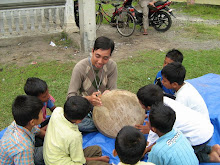David Spiro
As implementers and advocates for the development of inclusive education systems, we often find that local partners and government counterparts struggle to bridge the gap between “What is Inclusive Education?” and “How do we implement Inclusive Education?” This can result in the signing of declarations and passage of vague policies and laws but leads to little actual impact for students, schools and families.
It is therefore imperative that advocacy efforts, including policy development and improving governance, emphasize what must be accomplished as we move towards more inclusive education systems. However, it is just as vital that these efforts provide guidance for the development of specific educational mechanisms that will assist us in how to reach our goals. These mechanisms include the identification and enrollment of students, provision of support services, identification and training of support personnel, and development of appropriate management and administrative systems.
Identifying Specific Barriers experienced by Students, Families and Teachers
Identifying the specific barriers to learning is the first step in focusing advocacy efforts towards reducing and removing these. The identification of barriers should be evidence based in order to effectively guide policy developments and implementation at national, local, and community levels.
Barriers include any reason why a child does not have access to fair and appropriate education (based on the child’s needs) within his/her community. Children face barriers related to a disability, health, socioeconomic and cultural concerns, lack of government policies and protection, inaccessible infrastructure, language, geography, and low awareness of rights within the education system.
Barriers include (on national, local and community levels) awareness, teacher training and preparation, out-dated (or lack of) policies and regulations for enrollment procedures, transportation, inaccessible facilities, few linkages to health services, and prohibitive school costs and fees. These barriers explicitly identify issues that advocacy and policy should aim to resolve. [1]
Working to Design Detailed Action-Oriented Policy
After identifying barriers, the process of developing mechanisms to address them should be intensified. Rigorous advocacy initiatives should be implemented to persuade decision makers at all levels to take action. The mechanisms should be based on evidence and build on the lessons learned from other projects. Furthermore, the process must be inclusive of schools, parents, students, teachers, government administrators, and community leaders. As much as possible, the development of mechanisms should build on and be aligned with accepted political policies and processes. Identifying existing or excess resources for more efficient use (re-allocation to new implementation mechanisms) should be a priority. Using existing resources more effectively is helpful, especially before requesting new or additional resources from the government or other partners. Resources can include teachers or other personnel, equipment, facilities or funds.
While the mechanisms should be detailed, they should also be flexible and reasonable. They should be adjusted to suit the current local and national realities, while allowing room for continued development and adaptation. It is also important to work with partners to identify what kind of policy will be the most effective and through which government entity it should be passed. For example, in some countries, receiving a provincial decree or district regulation is more effective than one from the national education ministry.
Working with partners to advocate for and develop specific policy implementation mechanisms can be a lengthy process requiring intensive collaboration between many government and non-government stakeholders. It requires constant monitoring and advocacy to ensure that the initiatives move forward. It also requires an understanding of diplomacy and a respect for local bureaucratic procedures, which will ultimately be the channel through which the concepts are realized into policy. It is important to take a measured approach in order to understand unforeseen complications or benefits before wide-scale implementation is advocated and initiated. Initial approaches should include monitoring and evaluation in order to develop a rigorous evidence base for decisions and actions that optimally advance the process.
Targeted, flexible and evidence-based implementation mechanisms for advocacy work, will provide a road map for the development of inclusive education policies that are rooted in a legitimate and sustainable foundation.
[1] There are a number of tools that one can use to assist in the identification of first tier, second tier, and even third and fourth tier barriers. Logical Frameworks Approach (and associated Log Frame Matrixes), Problem Trees, school-community mapping, Community-based EMIS and other mapping tools can assist in organizing an overall framework in which to identify barriers or challenges and assign strategies to solve them. The internet is a good resource to learning more about these tools. (edp-europe.org)

 Print this page
Print this page

Tidak ada komentar:
Posting Komentar